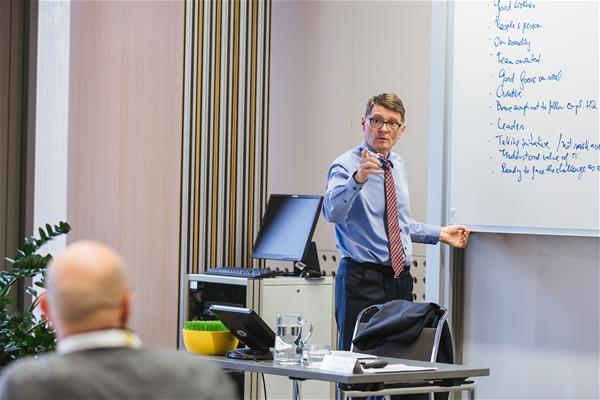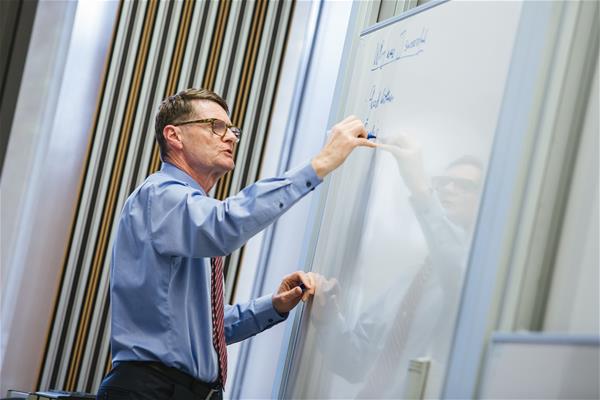Prof. Nenad Filipović
What are the core competencies that you aim to instill in participants during this particular module of the Advanced Management Program?
The approach we take reflects the realities of leadership and managerial profession: complexity and the need to use multiple mutually interrelated competencies. Some of them will explicitly be in the focus, while the others we will develop by using them without notice. In the first group, I would highlight the competencies of observation and interpretation of the situation at hand, as well as those of dealing with the biases and maintaining integrity of structured thinking. Among the central ones are certainly analytical and problem-solving competencies. We will also deal with competencies around effective communication, including emotional intelligence, as well as ethical considerations.
In today’s rapidly changing business environment, how can managers effectively apply critical thinking to navigate uncertainty and make sound decisions?
In times of rapid changes it is even more important to be able to think critically and it is more difficult to make sound decisions. In my opinion, it all starts with the ability to be observant and ready to interpret the business context. With the flood of new information bombarding us all the time it is important to filter out those, being of higher importance for us. The next step is to try to understand more holistically, what this input means. Why do we see what we see, what implications it may have for our business. This may require some time and effort, which we have to allocate routinely, as part of our daily or weekly schedule, as well as when receiving “breaking news”. Clearly, more important items may require team consultation or obtaining external view. A lot of activities related to this may be seen as expert work and may be done more effectively with use of appropriate frameworks or AI support, but at the end we still have to take ownership of the final result.
Could you share some practical tools or frameworks that participants will engage with to enhance their decision-making skills?
During the module we will mention or use quite a few frameworks, some as part of the teaching material, while others will pop up spontaneously, when discussing specific issues brought up by the participants. For sure we shall talk about various ways to prioritize, we will see how to turn data into information in a structured way, we will illustrate the use of McKinsey seven-step decision making process, use Situation-Complication-Questions-Answers framework, talk about the development of issue tree using MECE principle, and many more. However, we will all the time keep in mind that frameworks are potentially useful tools, but as with every other tool, one has to know which to apply when. Use of frameworks should never become a mechanical job.
How does this module address the challenges of cognitive biases and promote more objective analysis in managerial decisions?
Biases are all around us, because they are the natural product of human brain development and our chemistry. The good side of that problem is that by now we quite well understand how our brain works and how that produces typical biases. During the module we shall look at several group of biases (action-oriented, interest, pattern-recognition, stability, social) which often appear in business situations. We shall also look beyond them, how business setting makes us more prone to fall victims of biased thinking, as well as how leaders sometimes manipulate in order to create biases. We shall talk about the topic, but also watch two video clips that serve as video cases, as a starting point for focused experience-based discussion.
Can you provide an example of a real-world business scenario where critical thinking significantly impacted the outcome?
We see it all the time. Let me share just one example. Digitalization has become a “mantra”, every company is looking at it as possible source of business improvement. Rightly so. However, some companies do not apply critical thinking and are, for example, radically redesigning their distribution channels and reducing physical involvement with the customers. Research shows that even the “digital natives” want to keep physical interaction in certain elements of the customer journey. Working with boards of a number of companies I noticed the tendency not to engage in finding and critically interpreting the information on the digitalization, but to use arguments in a way as to support premeditated decisions.
What role you think the latest technology plays in the decision-making abilities of modern managers?
As noted above, the technology may provide us with great tools for accessing and interpreting information on a wide range of topics. I would see it primarily in the function of support, speeding up and making it more comprehensive. Latest efforts in the field of AI point in the direction of leaving some decision-making to the algorithms, but I believe that for the vast majority of decision classes we are far from robustness of outcomes. For some classes of decisions, especially those made on very small data sets as well as those with strong ethical component I would expect that for the time to come managers should keep the ownership over the decision. We have seen lately attempts to use AI in making hire / fire decisions, which grossly backfired. Not only that they sound inherently problematic from leadership perspective (people hiding behind anonymous algorithms, not being ready to take responsibility for the ultimate effects they were creating), but, after subjected to proper scrutiny, the algorithms proved to be far from quality one would expect in such a sensitive area.

How does the “Critical Thinking and Decision-Making” module complement the other modules in the AMP, such as “Leading for High Performance” and “Project Management”?
The AMP structure is not the result of a coincidence. If you look at basic flow of strategically important events in any company, they follow the same pattern. Based on appropriate input managers make strategic decisions in two principle areas: what should be the future shape of our business and how can we reach that from current position. Critical thinking and sound decision-making are huge drivers of quality in that area. Once the “strategic content” is determined, the company must organize itself to deliver the strategy. All the activities, which are not part of regular business, but are consequences of the changes driven by new strategy, will be delivered in the form of projects. Therefore, the quality of project management is essential. Lastly, even if managed well, the projects will not be effective unless teams delivering them are effective, are true high performance teams led by leaders fitting that label. So, topic-wise, AMP covers what matters most. On top of that, Drikus, Nick and I are well synchronized, each with own teaching style but following the same executive development philosophy.
With your extensive background in strategic management and leadership development, how have you seen the importance of critical thinking evolve in the corporate world?
Critical thinking has always been important, not only in business but in the society at large. What we see lately are challenges making it a more demanding area of human activity. Fake news are no news these days. Unfortunately, even serious business is exposed to large amount of questionable information, which managers have to process when making decisions. With exposure to huge amounts to information our biases actually grow stronger unless we make additional effort to curb them. On top of that, the complexity of the situations we face is growing and many of them have paradoxical elements in them, not allowing for simple “right-wrong” judgments. Time between decisions we have to make becomes shorter than time needed to make a single proper decision. All of that puts additional pressure on the managers and makes critical thinking and sound decision-making competencies required more than ever.
Apart from delivering shorter programs like AMP, you are teaching at various program of IEDC including Executive MBA, as well as you are extensively engaged with in-company programs. What trends or shifts have you noticed in the types of challenges businesses face, and how have these influenced the evolution of the courses that you deliver?
In a nutshell, as already mentioned: time pressure, need for holistic thinking, lack of simple solutions and large emotional component are hallmarks of today business. Courses reflect that, they are focusing on attitudes and skills more than knowledge, on helping participants to ask the right questions rather than giving them recipes or formulas for finding exact answers.

Your work at IEDC-Bled School of Management involves working with participants coming from diverse industries and cultures. How do you tailor your teaching to address the varied experiences of participants?
All of the participants I work with come with the level of business experience allowing them to contribute actively to the discussions. My main task is to create the setting where people engage and facilitate the exchange. Of course, my own experience allows me to adjust in terms of identifying the relevant topics and sharing input, which the particular group of participants can benefit from most, as well as to be able to provide fast feedback on the thoughts they bring into the discussion.
What inspired you to focus on strategy, critical thinking and decision-making in your academic and professional journey, and how has this focus influenced your approach to executive education?
I have spent the first fifteen years of my career in business, ending at the board level of an international manufacturing company with twenty five thousand employees. When I joined the world of executive education, I wanted to contribute in the area, which I felt was close to my experience and interest, but also extremely relevant: general management, looking at the company from the top. It is a complex area, bringing together topics like strategy, leadership ethics, corporate governance, corporate transformation and more. It is demanding, but also exciting, it is the true reflection of the most important dimensions of real life in business. Not many business schools have it in its focus, many prefer to be narrower and deal with separate topics. One department teaches strategy, another teaches organizational behavior. But in companies you don’t have these separation. That is why I thin executive education should look at the issues holistically. Also, we should not remember that it is not (only) about knowledge. Skills and, above anything else, attitudes, have bigger impact. That is why these topics and why in the why we do it in the Advanced Management Program.
.png?sfvrsn=1)
Original interview in pdf